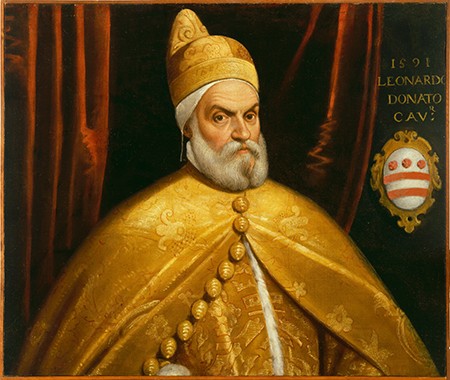I am conducting research on a key political figure of late sixteenth-century Venice, Leonardo Donà dalle Rose (1536–1612), who became doge at the end of his career. He is famous in political history for his role in the episode of the Venetian Interdict of 1606–1607, the culminating moment of a clash with the papacy. The goal of this study is to explore fully his unique role in the building of Venice. He was a member of all the commissions responsible for the city’s major architectural works of the period—the church of the Redentore, the urbanization of the Fondamenta Nuove, the palace of the Procuratie Nuove, the Rialto Bridge, the basilica of San Giorgio Maggiore, and the new town of Palmanova—in addition to overseeing the construction of his own palace and tomb. He actively participated in the design process, if not as an amateur architect, certainly as a project manager.
Donà was the leader of the party known as the Giovani (young ones), who promoted greater Venetian political autonomy as well as an austere lifestyle and ties with ancient civic traditions. He favored a style of architecture that drew on the origins of Venice, proposing a different idea of monumentality, one based on concepts such as authority, continuity, and sense of power and defined by size, location, and symbolic presence as opposed to pomp, splendor, or magnificence. In adopting this stance, he set himself in opposition to the Vecchi (old ones), who were oriented toward a close connection with the papacy, enjoyed pomp, were attracted to novelty, and admired Roman Renaissance architecture.
Thus in a way Donà belonged to the losing party: architecture went in another direction, that of all’antica style. But to what degree did he determine the built form of Venice? His role has never been truly studied from an architectural point of view, in spite of the importance of the works in which he was involved. The position of the “winners” has been widely explored; my project aims to redress the balance by reconstructing Donà’s role in the debate associated with the great interventions. In that debate, technological innovation and local traditional design were often opposed to all’antica practice, showing the multifaceted relationship between the terms “innovation” and “tradition.” One of my goals is to understand how he and his followers intended the different type of monumentality they advocated as a tool for maintaining or rebuilding the “myth of Venice.” A careful investigation of the procedures employed in carrying out projects and the roles of the personalities involved allows us to comprehend their complexity and contradiction, bringing to light a narrative outside the mainstream.
In a sense, Donà tried to maintain a cultural identity endangered by contemporary globalization. But he was not a provincial traditionalist. His life was strongly international and culturally open; he was in contact with leading minds of his day such as Giordano Bruno, Galileo Galilei, and Paolo Sarpi. He considered all aspects of his life public and left substantial written evidence that attests to his adoption of the ideal of identity between public and private life and to the building of his own myth.
The project offers the possibility of investigating in a broader political, intellectual, and sociocultural context issues related to art, technology, engineering, and material culture, connecting several humanistic fields in a multidisciplinary study. Moreover, it provides an opportunity to explore topics that resonate intensely with our time. These include relationships between globalization and local identity, mainstream and outlier, architecture and politics, church and state, innovation and tradition.
The research will culminate in a comprehensive book, now partially completed, on Donà and his role in the architectural politics of early modern Venice. The book will be structured in two parts: the first covering topics such as Donà’s life and career, his extensive travels, his country estates, his involvement in the great urban interventions, his family palace, and his tomb. The second part is devoted to the building of the Palazzo Donà dalle Rose, illustrating in detail chronology, materials, and techniques, with the aim of providing a vivid rendering of an early modern building site. During my fellowship at CASVA I worked on the first chapters, focusing especially on Donà’s travels and ambassadorial assignments in Europe and the Mediterranean basin, and on his reputation among contemporaries, which can be ascertained from a fortunate wealth of published materials. Discussions with the CASVA community of staff and fellows and the excellent resources of the National Gallery of Art Library have been invaluable in accomplishing important parts of my work.
